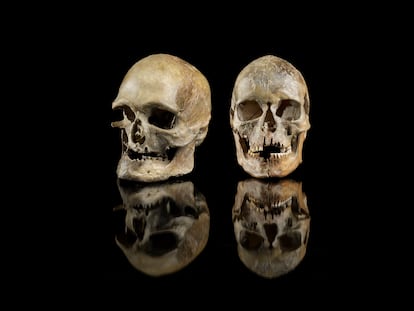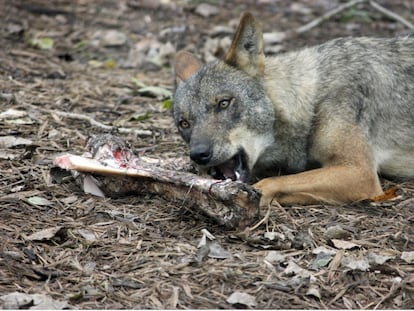First evidence for horseback riding dates back 5,000 years
Researchers analyzed more than 200 Bronze Age skeletal remains in museum collections in Bulgaria, Poland, Romania, Hungary and the Czech Republic

Archaeologists have found the earliest direct evidence for horseback riding – an innovation that would transform history – in 5,000-year-old human skeletons in Central Europe.
“When you get on a horse and ride it fast, it’s a thrill – I’m sure ancient humans felt the same way,” said David Anthony, a co-author of the study and Hartwick College archaeologist. “Horseback riding was the fastest a human could go before the railroads.”
Researchers analyzed more than 200 Bronze Age skeletal remains in museum collections in Bulgaria, Poland, Romania, Hungary and the Czech Republic to look for signs of what co-author and University of Helsinki anthropologist Martin Trautmann calls “horse rider syndrome” – six tell-tale markers that indicate a person was likely riding an animal, including characteristic wear marks on the hip sockets, thighbone and pelvis.
“You can read bones like biographies,” said Trautmann, who has previously studied similar wear patterns in skeletons from later periods when horseback riding is well-established in the historical record.
The researchers focused on human skeletons – which are more readily preserved than horse bones in burial sites and museums – and identified five likely riders who lived around 4,500 to 5,000 years ago and belonged to a Bronze Age people called the Yamnaya.
“There is earlier evidence for harnessing and milking of horses, but this is the earliest direct evidence so far for horseback riding,” said University of Exeter archaeologist Alan Outram, who was not involved in the research, but praised the approach.
The study was published Friday in the journal Science Advances.
Domesticating wild horses on the plains of Eurasia was a process, not a single event, the researchers say.
Archaeologists have previously found evidence of people consuming horse milk in dental remains and indications of horses controlled by harnesses and bits dating back more than 5,000 years, but that does not necessarily indicate the horses were ridden.
The Yamnaya culture, known for its characteristic burial mounds, originated in what’s now part of Ukraine and western Russia, an area called the Pontic Caspian steppe. The horses they kept were distinct from modern horses – likely more easily startled and less tolerant of humans – although they may have been the immediate genetic ancestors of modern horses, which emerged a few centuries later, the researchers say.
The Yamnaya are most significant because of their dramatic expansion across Eurasia in only a few generations – moving westward to Hungary and eastward to Mongolia, said University of Helsinki archaeologist and co-author Volker Heyd.
“The spread of Indo-European languages is linked to their movement, and they reshaped the genetic make-up of Europe,” he said.
Their relationship with horses may have partly enabled this stunning movement, the researchers suggest. “Horses expand the concept of distance – you begin to think about places previously out of reach as being reachable,” said co-author Anthony, the Hartwick College archaeologist.
That does not mean the Yamnaya people were warriors on horseback, as the horses they rode were likely too skittish for stressful battlefield situations, he said. But horses may have allowed the Yamnaya to more effectively send communications, build alliances and manage the herds of cattle that were central to their economy.
Because only a small percentage of the skeletons studied clearly showed all six markers of riding horseback, “it seems that a minority of the people at that time were riders – that does not suggest that a whole society was built on horseback riding,” said molecular archaeologist Ludovic Orlando, who is based at the Centre for Anthropobiology and Genomics of Toulouse in France and was not involved in the research.
Still, he praised the work for helping to better pinpoint the potential genesis of horseback riding.
“This is about the origins of something that impacted human history like only a few other things have,” said Orlando.
Sign up for our weekly newsletter to get more English-language news coverage from EL PAÍS USA Edition
Tu suscripción se está usando en otro dispositivo
¿Quieres añadir otro usuario a tu suscripción?
Si continúas leyendo en este dispositivo, no se podrá leer en el otro.
FlechaTu suscripción se está usando en otro dispositivo y solo puedes acceder a EL PAÍS desde un dispositivo a la vez.
Si quieres compartir tu cuenta, cambia tu suscripción a la modalidad Premium, así podrás añadir otro usuario. Cada uno accederá con su propia cuenta de email, lo que os permitirá personalizar vuestra experiencia en EL PAÍS.
¿Tienes una suscripción de empresa? Accede aquí para contratar más cuentas.
En el caso de no saber quién está usando tu cuenta, te recomendamos cambiar tu contraseña aquí.
Si decides continuar compartiendo tu cuenta, este mensaje se mostrará en tu dispositivo y en el de la otra persona que está usando tu cuenta de forma indefinida, afectando a tu experiencia de lectura. Puedes consultar aquí los términos y condiciones de la suscripción digital.
More information
Archived In
Últimas noticias
Most viewed
- Why we lost the habit of sleeping in two segments and how that changed our sense of time
- Trump’s obsession with putting his name on everything is unprecedented in the United States
- Pablo Escobar’s hippos: A serious environmental problem, 40 years on
- The Florida Keys tourist paradise is besieged by immigration agents: ‘We’ve never seen anything like this’
- Charles Dubouloz, mountaineering star, retires at 36 with a farewell tour inspired by Walter Bonatti










































